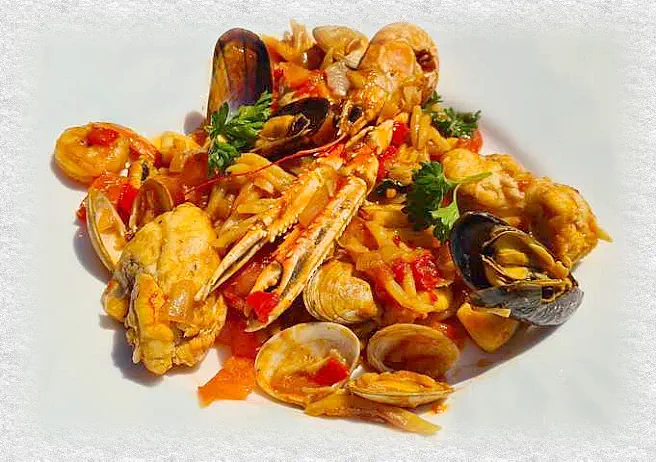

fideuada catalana
red peppers
passata
fresh tomatoes
paprika powder
shellfish stock
white wine
olive oil
fideos pasta
parsley
lemon

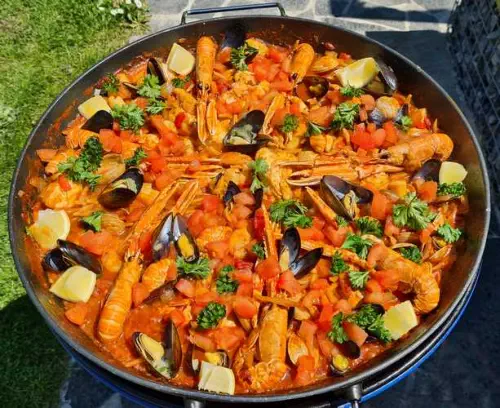
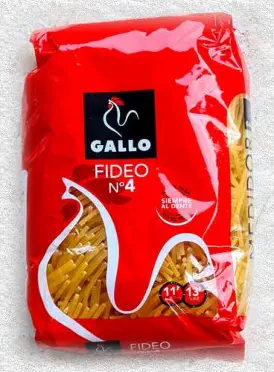
The Catalan fideuada is just the same as the typical
fideuà of Valencia. It looks like a regular paella, but
instead of rice, short thin pasta called 'fideos' is used.
Fideos can be bought in every Spanish supermarket. Not
so in Belgium. But you can replace this typical pasta with
the Italian trophie or other short pasta.
The recipe is said to have originated by accident about
100 years ago, when a ship's cook from the port town of
Gandia near Valencia, forgot to bring a bag of rice on
board, to make a paella. He used fideos in substitution.
Since the 1970s, that town has hosted an annual
international competition for the best fideuà. After that,
the Catalans made it their own. It was included in the
semi-official inventory of Catalan culinary heritage. A bit
of a copycat so to speak....
Preparing the vegetables. Chop the onions and a few garlic
cloves into fine pieces. Peel the red peppers and also cut them
into pieces. Skin the tomatoes and empty them. Cut the flesh
into cubes. Pull tufts of leaf parsley.
Prepare the fish and seafood. Cut the blades and legs from
all the crustaceans. Clean and dice the squid. Cut the whitefish
into large pieces. Clean and rinse the mussels and shells
several times in salted water so that they spit out their sand.
The rest of the cooking is done in the same paella pan, but
three times, emptying it each time for the next preparation.
Initial preparation. Sauté fish and seafood, except for the
clams and mussels, in a generous layer of olive oil. Scoop the
preparation from the paella pan and set aside, covered.
Second preparation. Do not replace the oil; add a little more if
necessary. Fry the Spanish fideos or other short, thin pasta
until it begins to color. Scoop the pasta from the pan and set
aside covered.
Third preparation. Again, add some oil. Fry chopped onions
first, add garlic and sliced peppers. Pour in equal quantities of
passata, shellfish stock and dry white wine. Let it reduce.
Season with pepper, salt and mild paprika. Then add the
mussels and clams. Pay attention to whether they open or not.
The closed ones are removed.
The assembling. Stir the vegetable preparation in the pan with
the baked pasta. And now it's time to pay attention.
Each type of pasta has its own cooking time. That can range
from 2-3 minutes for fresh pasta to 8 minutes or more for a
whole wheat product. Beyond that cooking time we move to
porridge. It is therefore important to choose the right moment
to add your pasta.
In addition, there should be just enough liquid in the pan for
the pasta to absorb it, but not too much either, because you
can't drain the pasta here. We want a juicy result but not a fish
soup. So, a moment of stress.
Add all the fish and seafood at this stage, so that they can
warm up during the cooking process of the pasta.
Finishing. Arrange the langoustines in a creative way in the
pan. Sprinkle with the diced tomatoes and garnish with parsley
and lemon wedges.
It looks like vermicelli, but it
is not. The most common
size fideo to make the
Catalan fideuada is the #4.





fideuada catalana
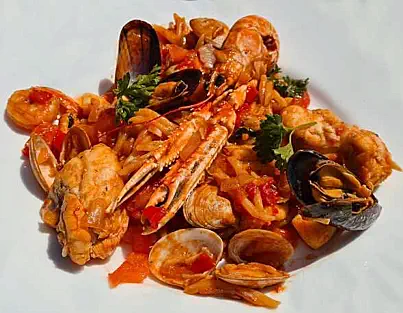
The Catalan fideuada is just the same as the
typical fideuà of Valencia. It looks like a
regular paella, but instead of rice, short thin
pasta called 'fideos' is used. Fideos can be
bought in every Spanish supermarket. Not
so in Belgium. But you can replace this
typical pasta with the Italian trophie or other
short pasta.
The recipe is said to have originated by
accident about 100 years ago, when a ship's
cook from the port town of Gandia near
Valencia, forgot to bring a bag of rice on
board, to make a paella. He used fideos in
substitution.
Since the 1970s, that town has hosted an
annual international competition for the
best fideuà. After that, the Catalans made it
their own. It was included in the semi-
official inventory of Catalan culinary
heritage. A bit of a copycat so to speak....

Preparing the vegetables. Chop the onions
and a few garlic cloves into fine pieces. Peel the
red peppers and also cut them into pieces. Skin
the tomatoes and empty them. Cut the flesh into
cubes. Pull tufts of leaf parsley.
Prepare the fish and seafood. Cut the blades
and legs from all the crustaceans. Clean and
dice the squid. Cut the whitefish into large
pieces. Clean and rinse the mussels and shells
several times in salted water so that they spit
out their sand.
The rest of the cooking is done in the same
paella pan, but three times, emptying it each
time for the next preparation.
Initial preparation. Sauté fish and seafood,
except for the clams and mussels, in a
generous layer of olive oil. Scoop the
preparation from the paella pan and set aside,
covered.
Second preparation. Do not replace the oil;
add a little more if necessary. Fry the Spanish
fideos or other short, thin pasta until it begins to
color. Scoop the pasta from the pan and set
aside covered.
Third preparation. Again, add some oil. Fry
chopped onions first, add garlic and sliced
peppers. Pour in equal quantities of passata,
shellfish stock and dry white wine. Let it reduce.
Season with pepper, salt and mild paprika. Then
add the mussels and clams. Pay attention to
whether they open or not. The closed ones are
removed.
The assembling. Stir the vegetable preparation
in the pan with the baked pasta. And now it's
time to pay attention.
Each type of pasta has its own cooking time.
That can range from 2-3 minutes for fresh pasta
to 8 minutes or more for a whole wheat product.
Beyond that cooking time we move to porridge.
It is therefore important to choose the right
moment to add your pasta.
In addition, there should be just enough liquid in
the pan for the pasta to absorb it, but not too
much either, because you can't drain the pasta
here. We want a juicy result but not a fish soup.
So, a moment of stress.
Add all the fish and seafood at this stage, so
that they can warm up during the cooking
process of the pasta.
Finishing. Arrange the langoustines in a creative
way in the pan. Sprinkle with the diced tomatoes
and garnish with parsley and lemon wedges.

red peppers
passata
fresh tomatoes
paprika powder
shellfish stock
white wine
olive oil
fideos pasta
parsley
lemon
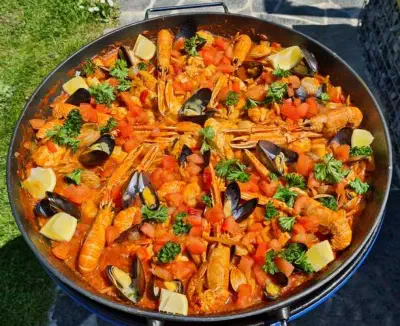
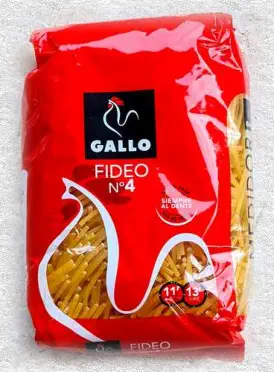
It looks like
vermicelli, but
it is not. The
most common
size fideo to
make the
Catalan
fideuada is
the #4.

















